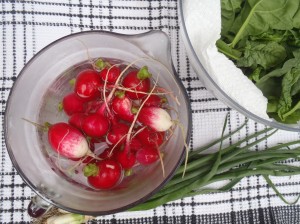 Since 2009, Lisa and I have been members of the Tipi Creek CSA. CSA usually stands for community supported agriculture, but at Tipi Creek Farm stands for community shared agriculture.
Since 2009, Lisa and I have been members of the Tipi Creek CSA. CSA usually stands for community supported agriculture, but at Tipi Creek Farm stands for community shared agriculture.
Here’s the skinny. In March we pay a flat fee. Three times between planting in May and the last harvest in September, we go to Tipi Creek and spend a few hours helping out. This may involve planting, weeding, or harvesting. In return for our money and labour, every week from roughly July to the end of September we get a shipment of vegetables.
Last year we received salad greens, spinach, Swiss chard, onions, leeks, kale, radishes, peas, beets, cucumbers, zucchini, broccoli, rhubarb, corn, pumpkins, squash, watermelon, potatoes, kohlrabi, beans, basil, and dill.
The Tipi Creek CSA has been a fantastic learning experience. Our first year with Tipi Creek was the first time I tried leeks, kale, kohlrabi, and Swiss chard. I became familiar with different varieties of otherwise common vegetables. For instance, on the last harvest day in September we left with Hopi, Buttercup, and Godiva squash. Most importantly I learned about produce quality. Corn that is broken from the stalk, husked, and eaten within a minute (which, by the way, I didn’t even know you could do, since we always boiled the cobs at my house) is impossibly sweet. After picking, the sugars in the corn quickly turn to starches, and after a day most of the sweetness is gone.
While there is a certain amount of risk involved (you pay the same amount no matter how well the crops do that year), it’s mitigated by the variety of vegetables planted. The summer of 2009, you may remember, was very dry, and a few crops, like corn, suffered. However, for some reason the cucumbers responded extremely well, and we received several kilos worth.
Which brings me to the quantity of vegetables received. Besides a few heads of lettuce and ears of corn passed along to Judy, and a really bitching Thanksgiving dinner for ten, Lisa and I didn’t really share the produce. It’s a lot of food for two people. Thankfully most of the items lend themselves to preservation by freezing, canning, or dry storage. It was the Tipi Creek vegetables that had us canning and drying food for the first time, as well as experimenting with natural (fermented) vegetable pickles. Honestly it was a lot of work. On shipment nights we might spend almost an hour blanching and freezing vegetables. The vegetables that don’t take well to preservation (leafy greens) are a little more troublesome. I made a lot of really bad lettuce soup our first year.
In 2010 Lisa and I weighed every vegetable that came into our home, and found the cost per weight for comparable items at the grocery store and farmers’ market, just to see exactly how much money we’re saving. The complete cost comparison is posted here.